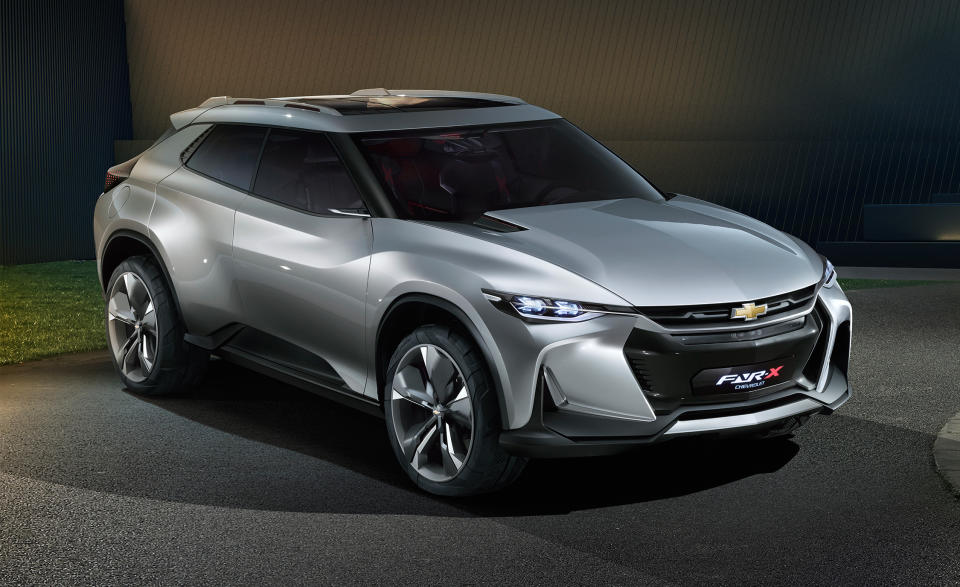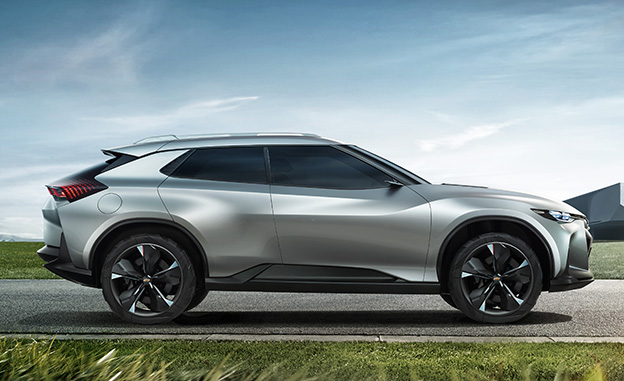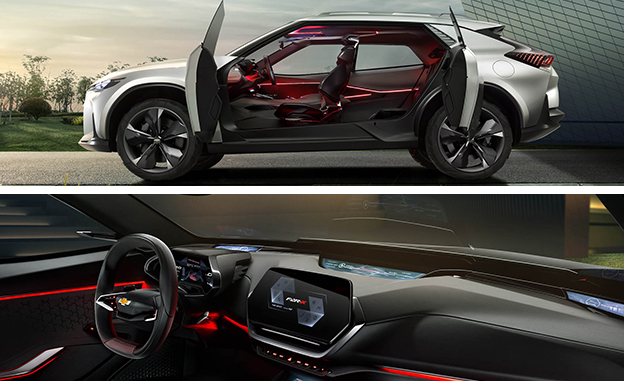Chevrolet FNR-X Concept Debuts, Looks Ready for Production

Two years ago at the Shanghai auto show, Chevrolet wowed the crowd with its futuretastic FNR (“Find New Roads”) concept car that was bad-ass in every way (except for being fully autonomous). That vehicle was said to provide “a glimpse into the mobility of the future.” Granted, it was a glimpse into a relatively far-out future wherein passenger cars boast hubless wheels, glass-dome roofs, “dragonfly” doors, and iris-scanner ID systems. For its follow-up act at the 2017 Shanghai auto show, Chevy offers a glimpse into a more near-term future with the attractive FNR-X plug-in-hybrid crossover concept which, despite its inelegant name, appears to be more suitable for production.
This latest concept looks like the love child of the FNR and Toyota’s kooky new C-HR crossover. From the original FNR, the FNR-X has inherited its high-mounted recessed headlamps and a bit of an underbite, with its hexagonal grille jutting forward at its lower edge. A Corvette-like domed hood flanked by tall ridges reaching from the grille back to the A-pillars could make for a distinctive forward view from the driver’s seat—something former General Motors design chief Ed Welburn predicted when we spoke with him in 2014—while the greenhouse serves up Saablike vibes with its blacked-out A- and B-pillars and thick, forward-canted C-pillar.

The overall proportions and roofline of the FNR-X are virtually identical to the C-HR’s, with its tall nose, rising beltline, severely slanted rear glass, and oversize wheels under black fender arches. Even the lower-door-trim treatments are similar. Yet from most every angle, the Chevy design appears more sophisticated. The FNR-X’s quad-element taillamps, for example, are elegantly tucked beneath the full-width rear glass versus the cantilevered light barnacles on the C-HR’s back end. And the FNR-X’s crisp body-side surfacing accentuates the fenders without resorting to outlining the wheel arches with deep gouges in the body as on the C-HR, where that treatment makes the vehicle’s midsection appear flabby.
Just as the FNR-X’s exterior looks as though Chevy could produce it today—and we wish it would—so does much of the interior. The primary infotainment screen echoes the shape of the grille, and is one of the cabin’s many hexagonal elements. And while what appear to be six separate information screens is probably overkill, the organic LED technology used here to facilitate screen-based connectivity functions for individual FNR-X passengers already is poised to proliferate throughout the industry sooner rather than later.

Chevy offered few details regarding what powers the concept other than to say that it has a plug-in-hybrid powertrain that allows the driver to switch between gas and electric propulsion. The Versatility and Sport driving modes are said to affect the deployment of the front and rear spoilers, the ambient interior lighting, and the tuning of the adaptive suspension, the latter also allowing drivers to adjust ground clearance to suit conditions. And while the FNR-X doesn’t promise the same level of autonomy as its predecessor, its Advanced Driver Assistance system employs optical and acoustic sensors as well as predictive navigation logic to attain what Chevy characterizes as “highly autonomous driver assistance.” Other cool features include the clumsily named “panoramic intelligent augmented reality head-up display,” which provides 270 degrees of outward vision to the rear and side, plus switchable wheel blades that automatically adjust to reduce aerodynamic drag at speed.
The FNR-X was designed by GM’s Pan Asia Technical Automotive Center (PATAC) and, as it turns out, is strictly conceptual according to a U.S.-based spokesperson. Yet even with the subcompact Trax and the all-new 2018 Equinox serving duty in this crossover space, there still would be room for a youthful, stylish model like this given that crossover mania shows no signs of abating. But please, Chevy, give it a real name.


 Yahoo Autos
Yahoo Autos 